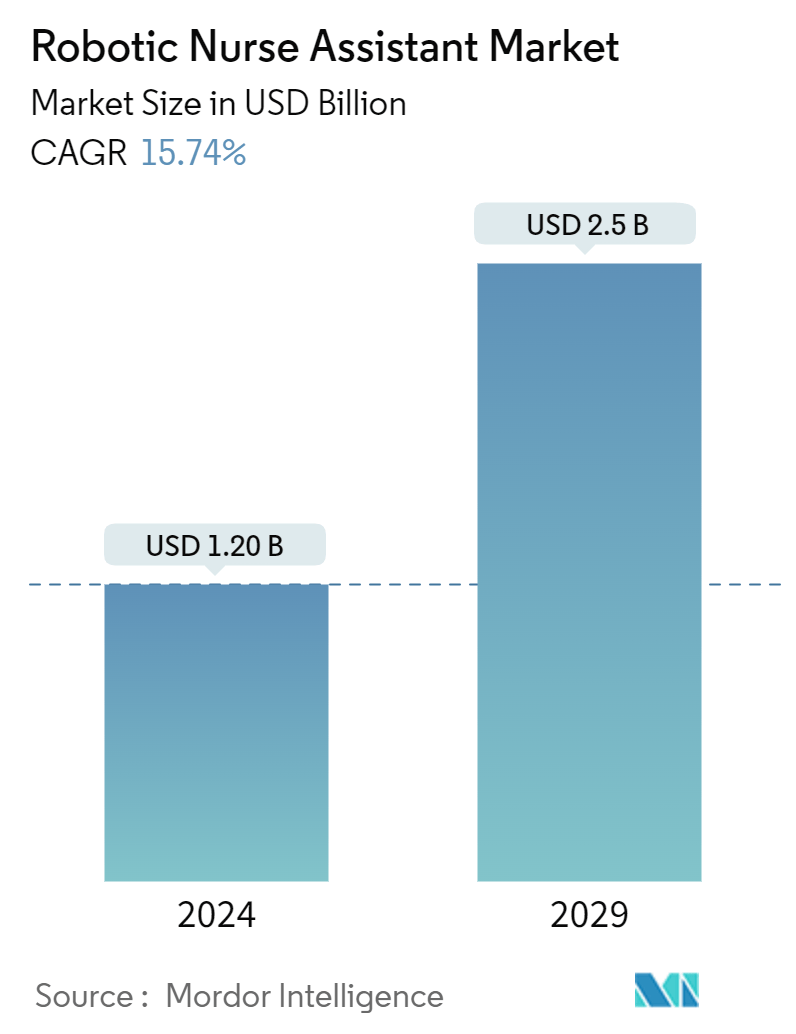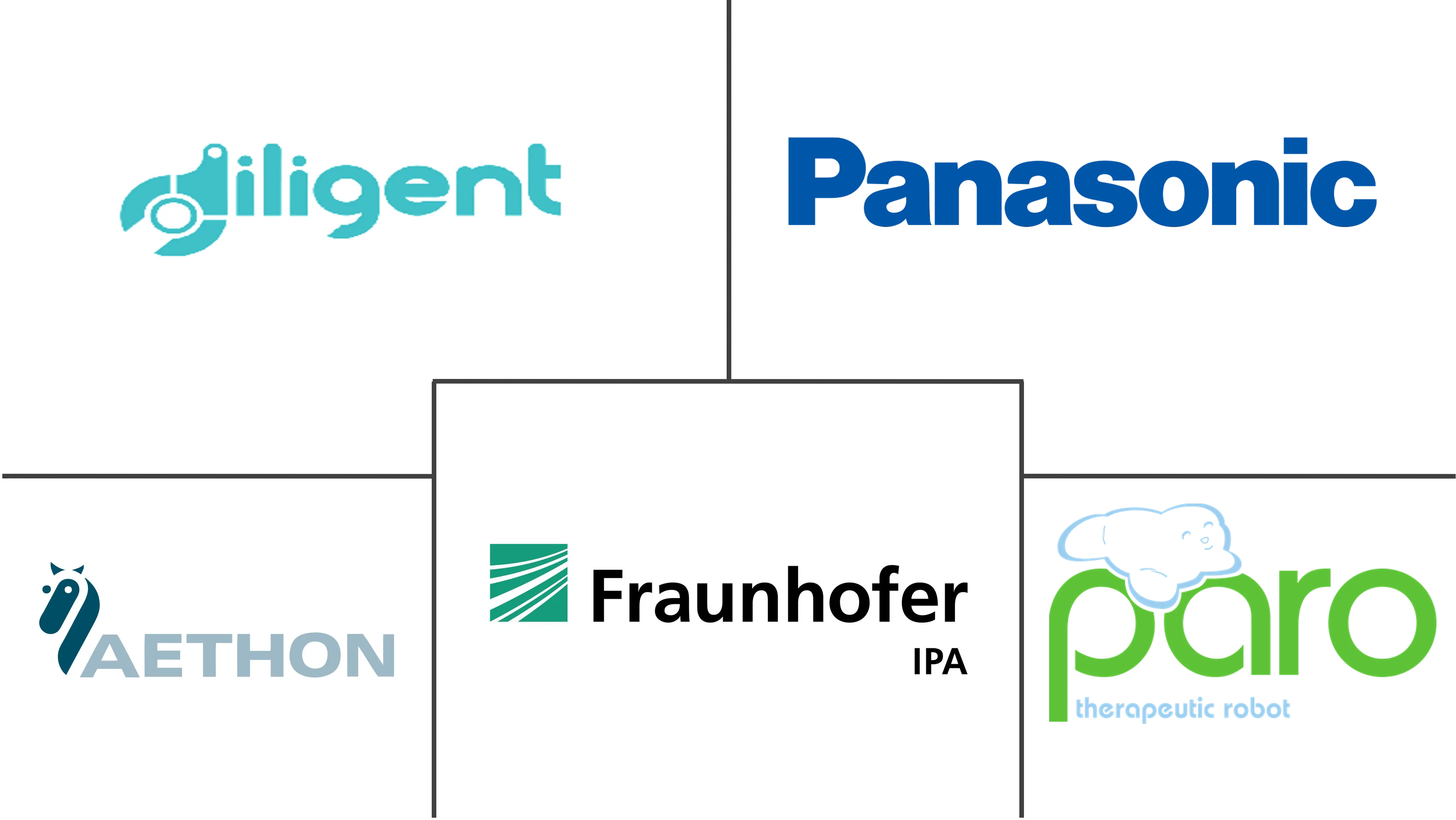Market Size of Robotic Nurse Assistant Industry

| Study Period | 2019 - 2029 |
| Market Size (2024) | USD 1.20 Billion |
| Market Size (2029) | USD 2.5 Billion |
| CAGR (2024 - 2029) | 15.74 % |
| Fastest Growing Market | Asia Pacific |
| Largest Market | North America |
| Market Concentration | Medium |
Major Players
*Disclaimer: Major Players sorted in no particular order |
Robotic Nurse Assistant Market Analysis
The Robotic Nurse Assistant Market size is estimated at USD 1.20 billion in 2024, and is expected to reach USD 2.5 billion by 2029, growing at a CAGR of 15.74% during the forecast period (2024-2029).
The factors supporting the growth of the robotic nurse assistant market include a growing senior population for various daily assistance functions and a rise in funding and grants for developing technologically advanced nurse-assisting robots. For instance, according to the World Population Prospects 2022, the proportion of the global population aged 65 and older is projected to increase significantly, rising from 10% in 2022 to 16% in 2050. These projections indicate that by 2050, the worldwide number of people aged 65 years or older will be more than double that of children under five years old and roughly equivalent to the number of children under twelve. Thus, the increasing geriatric population worldwide may create the need for robot nurse assistance, which is anticipated to drive the market over the projected period.
Moreover, a rise in funding and grants for developing technologically advanced nurse-assisting robots is expected to contribute to the market's growth over the forecast period. For instance, in June 2023, pre-clinical medical device company Microbot Medical received financing worth NIS 1.62 million (USD 440,000) from the Israel Innovation Authority (IIA) for its endovascular surgical robotic system LIBERTY. The grant will help further develop the manufacturing process linked to the LIBERTY Robotic Surgical System. Similarly, in April 2022, Diligent, a company developing nurse-assisting robots, secured over USD 30 million in series B funding. This investment will empower Diligent to enhance its scalability and address supply chain challenges as it continues to roll out its nurse-assisting robot, Moxi. These investments are anticipated to contribute to the growth of the market during the forecast period.
Furthermore, research and development for the next generation of robotic nurse assistants is ongoing to improve hospital nurse care. For instance, in January 2024, researchers from the National Robotarium in Paris, France, successfully tested next-generation socially assistive robots in a hospital setting. As part of the SPRING (Socially Assistive Robots in Gerontological Healthcare) trial, these robots were used to assist patients, alleviate anxiety, and ease the workload of nursing staff. The robots, equipped with advanced artificial intelligence, could hold natural conversations, understand patient needs, and aid hospital staff with routine tasks. The trial involved three waves of experiments with elderly volunteers at Assistance Publique Hôpitaux de Paris. Such research and development activities are expected to launch a new assistant that will contribute to market growth.
Thus, the growing geriatric population, increasing funding for developing technologically advanced robotic nurse assistants, and growing research and development activities are expected to boost segment growth over the forecast period. However, the high cost of robots is expected to hinder the market's growth over the forecast period.
Robotic Nurse Assistant Industry Segmentation
As per the scope of the report, robotic nurses are used for various activities like supporting disabled, critically ill patients and older people in performing their day-to-day tasks, as well as interacting with and monitoring patients.
The robotic nurse assistant market is segmented by product type, end user, and geography. By product type, the market is segmented into independence support robots, daily care and transportation robots, and other product types. By end user, the market is segmented into hospitals and clinics, senior care facilities, homecare settings, and other end users. By geography, the market is segmented into North America, Europe, Asia-Pacific, Middle East and Africa, and South America. The market report also covers the estimated market sizes and trends for 17 countries across major regions globally. The report offers market sizes and forecasts in terms of value (USD) for the above segments.
| By Product Type | |
| Independence Support Robots | |
| Daily Care and Transportation Robots | |
| Other Product Types |
| By End User | |
| Hospitals and Clinics | |
| Senior Care Facilities | |
| Homecare Settings | |
| Other End Users |
| Geography | ||||||||
| ||||||||
| ||||||||
| ||||||||
| ||||||||
|
Robotic Nurse Assistant Market Size Summary
The robotic nurse assistant market is poised for significant growth, driven by the increasing global senior population and advancements in healthcare technology. The demand for robotic nurse assistants is expected to rise as the elderly population grows, necessitating assistance in daily activities and healthcare settings. This trend is further supported by substantial funding and grants aimed at developing sophisticated nurse-assisting robots, which are enhancing the capabilities and deployment of these technologies in hospitals. Research and development efforts are also underway to create next-generation robots that can interact socially and assist with routine tasks, thereby improving the efficiency of healthcare delivery. Despite the high costs associated with these robots, the market is anticipated to expand due to the pressing need for healthcare solutions that address workforce shortages and improve patient care.
In North America, the robotic nurse assistant market is expected to thrive due to advanced healthcare infrastructure and significant investments in research and development. The region's growing prevalence of chronic diseases and an aging population are driving the demand for robotic assistants, which are increasingly being integrated into hospital settings to support healthcare staff. The introduction of innovative robotic systems, such as those developed by Diligent Robotics and other major players, is expected to enhance operational efficiency and patient care. Collaborative efforts and strategic investments are likely to intensify competition in the market, with key companies focusing on optimizing supply chains and expanding their product offerings. As hospitals continue to adopt these technologies, the market is projected to experience robust growth over the forecast period.
Robotic Nurse Assistant Market Size - Table of Contents
-
1. MARKET DYNAMICS
-
1.1 Market Overview
-
1.2 Market Drivers
-
1.2.1 Growing Geriatric Population
-
1.2.2 Rise in Funding and Grants for the Development of Technologically Advanced Nurse-assisting Robots
-
-
1.3 Market Restraints
-
1.3.1 High Cost Associated With Robots
-
-
1.4 Porter's Five Forces Analysis
-
1.4.1 Threat of New Entrants
-
1.4.2 Bargaining Power of Buyers/Consumers
-
1.4.3 Bargaining Power of Suppliers
-
1.4.4 Threat of Substitute Products
-
1.4.5 Intensity of Competitive Rivalry
-
-
-
2. MARKET SEGMENTATION (Market Size by Value - USD)
-
2.1 By Product Type
-
2.1.1 Independence Support Robots
-
2.1.2 Daily Care and Transportation Robots
-
2.1.3 Other Product Types
-
-
2.2 By End User
-
2.2.1 Hospitals and Clinics
-
2.2.2 Senior Care Facilities
-
2.2.3 Homecare Settings
-
2.2.4 Other End Users
-
-
2.3 Geography
-
2.3.1 North America
-
2.3.1.1 United States
-
2.3.1.2 Canada
-
2.3.1.3 Mexico
-
-
2.3.2 Europe
-
2.3.2.1 Germany
-
2.3.2.2 United Kingdom
-
2.3.2.3 France
-
2.3.2.4 Italy
-
2.3.2.5 Spain
-
2.3.2.6 Rest of Europe
-
-
2.3.3 Asia-Pacific
-
2.3.3.1 China
-
2.3.3.2 Japan
-
2.3.3.3 India
-
2.3.3.4 Australia
-
2.3.3.5 South Korea
-
2.3.3.6 Rest of Asia-Pacific
-
-
2.3.4 Middle East and Africa
-
2.3.4.1 GCC
-
2.3.4.2 South Africa
-
2.3.4.3 Rest of Middle East and Africa
-
-
2.3.5 South America
-
2.3.5.1 Brazil
-
2.3.5.2 Argentina
-
2.3.5.3 Rest of South America
-
-
-
Robotic Nurse Assistant Market Size FAQs
How big is the Robotic Nurse Assistant Market?
The Robotic Nurse Assistant Market size is expected to reach USD 1.20 billion in 2024 and grow at a CAGR of 15.74% to reach USD 2.5 billion by 2029.
What is the current Robotic Nurse Assistant Market size?
In 2024, the Robotic Nurse Assistant Market size is expected to reach USD 1.20 billion.

